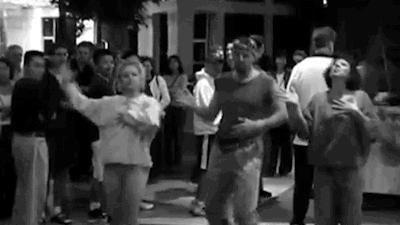Spike Jonze is a very successful director well known for his television appearances as an actor, his producing and screenwriting roles. He began his feature film directing career with films such as Adaption (2002) whilst he then went on to directing music videos such as Kanye West's Only One ft. Paul McCartney, Beastie Boy's Time for Livin' and Weezer's Buddy Holly to name just a few. Over the years he has won many awards such as for 'best choreographer'.
Jonze's success is almost holey due to his unique ideas that completely go against Andrew Goodwin's music video laws which are definitely on the more traditional side of things. Jonze has the ability to come up with 'one crazy idea' and revolve the entire music video around it which means that his originality shines through in each of his videos, showing that he breaks the conventions of standard videos. Two of his most successful music videos are Fatboy Slim's 'Praise You' and The Pharcyde's 'Drop'.
The Pharcyde 'Drop'
This video shows the Behind the Scenes and the making of 'Drop'.
Fatboy Slim- 'Praise You'
The video revolves around a flash mob, choreographed and directed by Jonze himself (he also stars in the video as one of the lead dancers), to the song 'Praise You' outside a local movie theater in California. It is in the form of a guerilla style meaning that there was no permission from the owners of the site- at one point a worker walks over and turns their portable stereo off. The video only cost $800 to produce (this was mainly to pay for replacing the stereo and feeding the dancers)- with this, it ended up winning 3 major music awards at the MTV VMA's in 1999 and was voted the number 1 best video of all time out of the top one hundred. All of the choreography and the idea of this video was completely original, as before websites such as YouTube, flash-mobs were not known of and when performed in a public place, it creates an element of surprise which is pleasing to an audience. This video was also produced in an unusual style, breaking the conventions of a typical music video- this is as at the end and the beginning, there is talking and it seems more like a documentary than a music video until the songs starts playing. Also in terms of mise en scene, they all look very ordinary (not like typical stars of a music video and dressed up for the occasion) which can create even more of a connection between the dancers and the viewers at home as they are so similar in how 'everyday' they appear which has a personal response. They also stay in one main location whereas in many other music videos, it is the norm to have multiple locations. The people in the video are not professional dancers (they are in fact not very good at dancing at all) this creates a sense of just not caring what people think and supports the common phrase ''dance like no one is watching'' which is also a relatable factor to the audience. One of the most obvious things I noticed when viewing this video is the fact that Norman cook aka Fatboy Slim (the artist) doesn't appear as the main star himself which can divert even more interest to what's happening in the video as the audience may feel perplexed and want to know the story behind it.
We will use some elements of Jonze's videos in our own music video- we could do this by completely breaking the conventions of typical music videos (like Spike Jonze does) such as by possibly not having the main artist star in it. Or we could use elements such as reversing as it creates a very unique and intriguing effect to make an audience want to continue watching.
I have noticed that Spike Jonze goe directly against Andrew Goodwin's theory of music videos which consists of the basic conventions that all (or most) videos have from a concept/narrative/performance based video to voyeurism. I think that it is a good idea that Jonze disregards Goodwin's theory as it makes his videos completely different from the rest in order from them to stand out and draw popular media attention to them. I feel that music videos which are unique and individual are typically more successful than other 'conventional' videos as they offer something more enticing than a standard video with a concept that everyone has more than likely seen before. I think it is important, for my group, to reach a point that our own music video has an equal balance between Jonze's and Goodwin's ideas as both combined seem to make a very successful video. We want our music video to stand out and have unique traits but we also still want that conventional spin to it for structure.





No comments:
Post a Comment